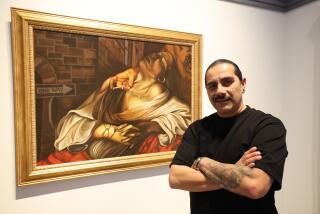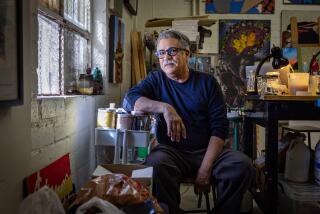‘Wifredo Lam’ at the Museum of Latin American Art
IN 19th CENTURY EUROPE, when modern science bumped aside the Christian God as the primary artistic foundation for meaning and moral value, artists lost a subject that had preoccupied them for hundreds of years. “Show me an angel and I’ll paint one,” the famously combative showman Gustave Courbet told his detractors. A search for truth trumped its declaration in the depiction of religious narrative.
But even though religion largely disappeared from art, spiritual interests did not. Not by a long shot. Those interests instead became a prime engine, especially for abstract art. Wifredo Lam (1902-82), whose work is the focus of a handsome and long overdue survey at the Museum of Latin American Art in Long Beach, is typically acknowledged for his painterly fusion of Cubism’s multiple viewpoints with Surrealism’s embrace of the irrational. But that formal synthesis was undertaken for decidedly spiritual purposes. Lam was Creole -- Afro-Spanish on his mother’s side, Cantonese on his father’s -- and that hybrid identity is reflected in his art.
Lam is one of those second-tier Modern artists -- there are a lot of them -- whose work rarely fails to impress when it is encountered but isn’t encountered nearly often enough. Out of sight, out of mind, his paintings have become perpetual surprises.
The Cuban painter’s most famous work is the monumental 1943 “The Jungle,” acquired with considerable fanfare by New York’s Museum of Modern Art a few years after it was made. Nearly 8 feet tall and almost square, it shows a dense, rhythmically configured lineup of masked animal-people arrayed amid tall stalks of sugar cane and bamboo. Flecked with patches of crimson and gold, the dominant blue-green hues cast a moonlight glow over the strange scene. Patterns of color season its wondrous sense of spiritual mystery.
Last year, the Los Angeles County Museum of Art acquired Lam’s 1947 “Tropic,” an important example from the artist’s most accomplished period. (His best work was made in his native Cuba in the 1940s and in Europe in the 1950s.) A yellowish light smolders beneath the deep moss-green surface of “Tropic” -- a favorite Lam palette, filled with the visual aroma of fecundity. The color illuminates a sharply delineated cluster of fantastic figures that are part animal, part human and part vegetable, darting in and out of view and swooping overhead like crosses between flying fish and pterodactyls. “Tropic,” like “The Jungle,” is a rattling fusion of precise Cubist spatial organization and vague Surrealist improbability.
The traveling exhibition in Long Beach is the largest American museum exhibition of Lam’s work since his death and the only one outside New York in nearly half a century. Spanning his career, “Wifredo Lam in North America” is drawn from eight public and numerous private collections. Organized by the Haggerty Museum of Art at Milwaukee’s Marquette University, the 57 paintings on canvas and paper -- many of his most impressive paintings, including “The Jungle,” are on paper -- offer a concise introduction to a complex artist’s work.
Lam was born Wilfredo Oscar de la Concepción Lam y Castillo in the small Cuban coastal city of Sagua La Grande, due south of Miami. (He later dropped the “l” from his first name.) His Catholic godmother, Mantonica Wilson, was a Santería priestess, practicing side by side religions codified in Europe and Africa but transformed in colonial Cuba.
At 21, after studying art in Havana, Lam left for Madrid. He spent the next 15 years in Spain. When he moved to Paris in 1938, with a letter of introduction to Picasso, he had acquired the technical skills to put into play what he would discover there.
And he discovered a lot. The next three years were intense -- socially, politically and artistically -- and would prove decisive for Lam’s art. Picasso introduced him to Henri Matisse and Joan Miró. Picasso’s form, Matisse’s color and Miró’s space would all find a home in his paintings.
Picasso also encouraged his interest in African masks and totemic carvings. Africa became Lam’s ancient Greece -- an artistic fountainhead.
He met André Breton, leader of the Surrealist movement, and when the German army invaded Paris was thrown together with the Surrealists into the intellectual stew of Marseille. Historically, the Mediterranean port had also been France’s colonial gateway to North Africa.
With Breton, the structural anthropologist Claude Lévi-Strauss and many others, Lam left for the Caribbean in 1941. Resettling in Havana, he found himself possessed of a deeper curiosity about -- and an intuitive understanding of -- the cultural milieu into which he had been born. And with the world in flames from Europe to the Pacific, he was back home in the relative calm of Cuba.
In the Long Beach show, three nearly adjacent paintings of women demonstrate how far Lam’s art quickly traveled. There’s a romantic realist portrait set against a starry indigo sky; a relaxed figure at a cafe table, in front of a window dotted with stylized flowers, that is pure Matisse; and finally, a woman with waist-length hair whose vertical striations intersect with the horizontal stripes of her shirt, creating a modern scarification that matches the African mask of her face. The first painting was made in 1931, the last in 1938.
But it was the return to Cuba that allowed Lam to transform, not merely mimic, the myriad influences he had absorbed. Unfortunately, MOMA’s “The Jungle,” which represents the turning point, is not in the show. (A large, very adept study for the work is included.) The first wholly original masterpiece is “Dark Malembo, God of the Crossroads,” also from 1943, a picture of a totemic, multi-headed creature with the torso of a horse, surrounded by bamboo, lush foliage and playfully wide-eyed suggestions of woodland spirits. The fantastic figure stands like a magical sentinel at the entrance to a harsh but beautiful world, which can be known sensually if not intellectually.
The deliriously hybrid nature of Lam’s art makes it of special interest to the way art has developed in the quarter-century since his death. Purity is out, hybridity is in. Reintroducing him to American museum audiences, the show is smart to focus on paintings in North American collections, which give an idea of what is already in our midst.
Lam is much better known in Europe, and he is of course a Modern hero in Cuba. (Havana’s National Museum of Fine Arts houses about 200 paintings on canvas and paper.) With luck, we won’t have to wait decades for a full-scale museum retrospective.
christopher.knight@latimes.com
More to Read
The biggest entertainment stories
Get our big stories about Hollywood, film, television, music, arts, culture and more right in your inbox as soon as they publish.
You may occasionally receive promotional content from the Los Angeles Times.







